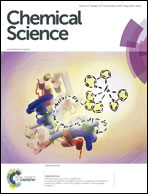Synthesis and reactivity of a PCcarbeneP cobalt(i) complex: the missing link in the cobalt PXP pincer series (X = B, C, N)†
Abstract
We report the first example of a cobalt PCcarbeneP pincer complex (1) featuring a central alkylidene carbon donor accessed through the dehydration of an alcoholic POP proligand. Complex 1 shares bonding similarities with cobalt PBP and PNP pincer complexes where the donor atom engages in π-bonding with the cobalt centre, and thus completes the PXP (X = B, C, N) pincer ligand series for cobalt (for X donors that partake in M–L π-bonding). As compared to PBP and PNP pincer complexes, which are known to be good hydride and proton acceptors (respectively), complex 1 is found to be an effective hydrogen atom acceptor. Complex 1 partakes in cooperative ligand reactivity, engaging in several small molecule activations with styrene, bromine, carbon disulphide, phenyl acetylene, acetonitrile, hydrogen, benzaldehyde and water (through microreversibility). The mechanism for the formation of complex 1 is studied through the isolation and computational analysis of key intermediates. The formation of 1 is found to avoid C–H activation of the proligand, and instead proceeds through a combination of O–H activation, hydrogen atom transfer, β-hydride elimination and hydrogen activation processes.



 Please wait while we load your content...
Please wait while we load your content...